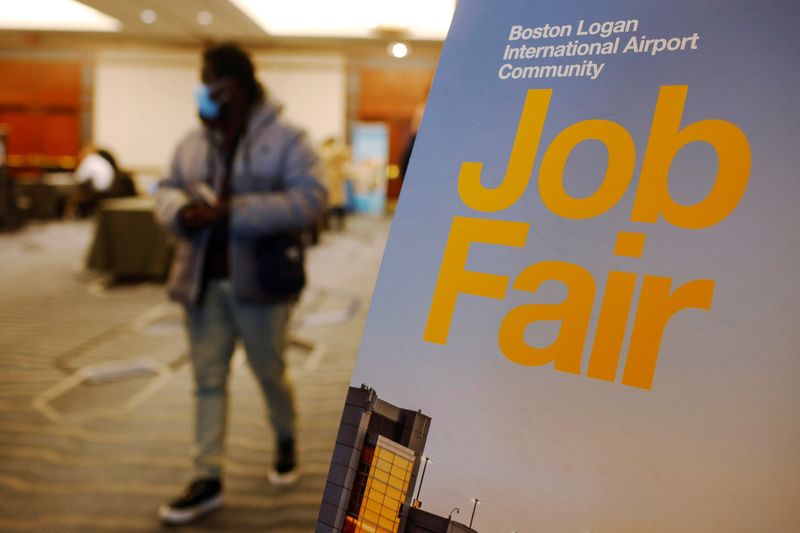By Howard Schneider
WASHINGTON (Reuters) – A recent surge in U.S. productivity has underscored Federal Reserve Chair Jerome Powell’s emerging narrative for how inflation may continue to decline even amidst sustained job and economic growth.
The best-of-both-worlds outcome would rely on the U.S. finding a new balance between the demand for and the supply of goods and services less by “destroying” demand – the way Fed interest rate increases typically play out – and more through improvements in the economy’s capacity.
In what has been a somewhat unheralded surprise, that is what has been unfolding through both improvements in the number of people willing to work, including new immigrants, and also through improvements in how much each worker produces, a dynamic that lowers effective labor costs even if wages are higher.
New data released Wednesday showed productivity grew an outsized 4.7% in the third quarter, the largest increase in three years and the second large gain this year. That caused unit labor costs to fall at a 0.8% annualized rate.
The net result is higher potential output with less inflationary risk, something Powell pointed to on Wednesday in his most extensive comments to date on the possibility that for the moment at least the economy may have an enhanced ability to grow, add jobs, and raise wages without adding to inflation.
The October employment report due on Friday at 8:30 EDT (1230 GMT) will provide updated estimates of the size of the labor force, a critical piece of the puzzle. After stalling through much of 2022, the workforce grew by 3 million workers, or about 2%, in the nine months through September.
The dynamic is one reason why the Fed kept its policy interest rate on hold at 5.25%-5.50% at its meeting this week despite recent data showing the economy grew at a 4.9% annualized rate in the third quarter – far beyond the 1.8% rate Fed officials see as the underlying long-term, noninflationary trend.
Throughout the pandemic era growth has largely exceeded that rate even as inflation has continued to fall, and Powell at his post-meeting press conference on Wednesday tried to square the circle.
“People think trend growth over a long period of time is a little less than 2%,” Powell said. But “potential growth is elevated for a year or two right now over its trend level…you’re seeing actually elevated potential growth, catch up growth, that can happen” because of improvements in things like labor supply that, all things equal, allow the economy to grow faster without the same price pressures. Along with more people working, productivity adds a boost as well.
CAN IT LAST?
Higher potential growth provides more leeway for the economy to grow without the Fed worrying about the impact on prices. In other words, it offers a wider runway for the “soft landing” Fed officials have hoped to engineer with inflation falling but the economy largely left on track.
Rising productivity “signals receding inflationary pressure even as the economy continues to display notable resilience,” said EY Senior Economist Lydia Boussour. “If companies can generate strong productivity growth, they will not be so inclined to pass elevated input costs onto consumers.”
The Fed’s situation mimics in some ways the mid-1990s, when Alan Greenspan – the central bank’s chief at the time – resisted pressure to raise interest rates, arguing that rising productivity would let the economy grow with less inflation, an insight credited with keeping that decade’s strong economic performance on track.
The spread of Web-based technologies was still in its relative infancy then, and the years since have produced not only more tempered productivity numbers, but a generally dismal assessment that trend growth in output per worker hour was only around 1.5%. That, coupled with sluggish population growth, is the reason Fed officials in recent years have steadily downgraded their view of the long-term trend growth in overall economic output, with the median fixed at around 1.8% since 2016.
Powell and his colleagues must now decide just how sustainable the recent improvements are.
The upside, as Powell described it, is the possibility of a virtuous cycle developing in which jobs remain plentiful, wages grow, and the economy continues to expand – all with a steady “disinflation” as the pace of price pressures fall back to 2%.
“The dynamic has been really strong job creation, with wages that are higher than inflation…and that raises real disposable income, that raises spending, which continues to drive more hiring,” Powell said. “It has been good. And the thing is, we’ve been achieving progress on inflation in the middle of this.
“The question is, how long can that continue?”
If and when it stops, the Fed may face the tougher choice of just how much the economy – the demand side at least – needs to slow to keep inflation in line.
“Growth is going to be slower this quarter…Higher rates are dampening activity here and there,” wrote TSLombard Chief U.S. Economist Steven Blitz. But “if real growth continues apace, disinflation runs its course and enough inflation eventually returns to pull the Fed back into a tightening cycle.”
(Reporting by Howard Schneider; Editing by Dan Burns and Andrea Ricci)

